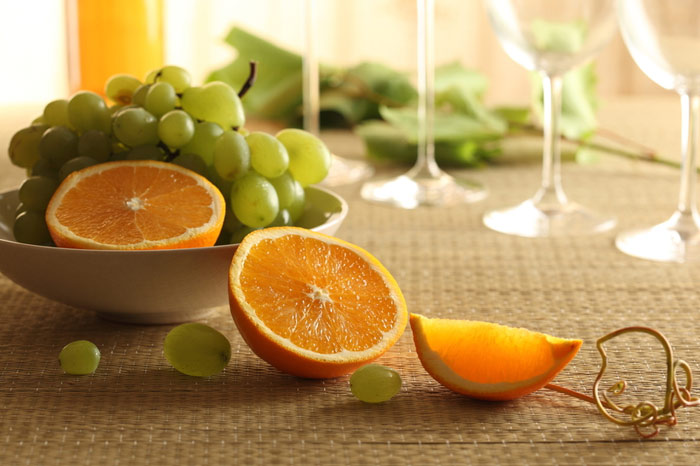Any sports activity takes a lot of effort and resources on the part of the body. In order to exercise and develop your body, you need to provide all of the required elements. We offer you a list of products that will help in this difficult matter.

White grapefruit
This is a good option to start a new energetic day. White grapefruit contains an impressive amount of vitamin C, potassium, and folic acid. Potassium will protect your muscles from cramps, so fresh grapefruit is the perfect drink after a jog, especially on a hot day.
Red grapefruit
Red grapefruit contains about as much vitamin C as white grapefruit does. Also, this fruit should be consumed due to the presence of vitamin A and pantothenic acid, which is used by the body to convert proteins, fats and carbohydrates into sources of energy for the body. That is why fresh red grapefruit juice in the morning can replace coffee; it will invigorate you equally well.
Orange
Oranges are a well-known source of vitamin C. In addition to maintaining the immune system, this vitamin performs another very useful function for anyone involved in sports – it eases muscle pain.
Leek
Leek is a great vegetarian source of iron and vitamins A and K.
Blackberry
Blackberries are low in calories and full of antioxidants; they contain a decent amount of fiber, vitamin C and vitamin K, which makes your bones stronger. Besides, blackberries are a very tasty addition to your breakfast cereals, such as oatmeal, that will fill you with energy before your morning jogging.
Turnips
Turnip is low in carbohydrates, but contains a lot of vitamin C, magnesium, iron, and calcium. It is especially good in late winter or early spring, when the body starts to experience vitamin hunger.
Radishes
Besides a large amount of vitamin C, which we have already written about more than once, radishes are known for the high water content that helps to restore the water reserves of the body.
Strawberries
Strawberries are marked by the high content of vitamin C and anthocyanins, which help the body in restoring the muscles tired after workouts.
Anthocyanins are dyed plant glycosides, containing anthocyanidins, serving as aglycone. These are substituted 2-phenylpropenes belonging to flavonoids. They are considered secondary metabolites. They are allowed as food additives (E163).
Lemon
Like other citrus fruits, lemon contains large amounts of vitamin C. In addition, it includes thiamine and folic acid. For example, thiamin converts carbohydrates into energy, so it is advisable to include lemon in your diet before workouts and competitions.
Thiamin (vitamin B1; the old name is aneurin) is a water-soluble vitamin, a compound corresponding to the formula C12H17N4OS. This is a colorless crystalline substance, soluble in water, but insoluble in alcohol. It is destroyed by heating.
Known as vitamin B1, thiamine plays an important role in the metabolism of carbohydrates, fats and proteins. This substance is needed for the normal processes of growth and development and helps maintain proper functioning of the heart, nervous and digestive systems.
Tomatoes
Tomatoes are rich in vitamins A, K and C, so they are a real superfood for everyone who leads an active lifestyle. An ideal snack would be a salad with tomatoes, fresh basil, lemon juice, and some olive oil.
Carrots
Carrots are full of vitamin A, vitamin B6 and carotene. Vitamin A refers to fat-soluble vitamins, i.e. you need to add some fat to ensure that the body gets enough of this vitamin. It is better to grate a carrot and add a little oil. For example, walnut oil is especially tasty.
Cabbage
Cabbage is another low-calorie source of vitamins K, C, and folic acid, which helps protect red blood cells.
Folic acid (vitamin B9; lat. acidum folicum from lat. folium — leaf) is a water-soluble vitamin necessary for the growth and development of the blood circulatory and immune systems.
Folic acid is required for the creation and health maintenance of new cells, so its presence is especially important during the periods of rapid development of an organism at the early stage of fetal development and in early childhood. The process of DNA replication requires the participation of folic acid, while the disruption of this process increases the risk of developing cancerous tumors. The bone marrow with active cell division is the first to suffer from the lack of folic acid. Progenitor cells of erythrocytes (red blood cells) that are produced in the bone marrow increase in size in case of the deficiency of folic acid, forming the so-called megaloblasts, which leads to megaloblastic anemia.
Parsley
Parsley is a source of iron, vitamin C, manganese and copper; it promotes good functioning of the digestive system. Parsley is one of the few plants that preserves all its useful properties when kept frozen for the next few months, so this is an ideal candidate for frozen vitamins.
Red bell pepper
Red bell pepper is an excellent source of vitamins C, A, and B6. Vitamin B6 helps the body to create hemoglobin, which carries oxygen to red blood cells and the muscle tissue.
Arugula
Arugula is rich in vitamins A, K, and C, as well as important minerals, such as magnesium, calcium, manganese, and potassium. It can be added to salad or pizza and serves as a complement to sandwiches. You can also use it to cook the pesto sauce by replacing basil in the standard recipe. It turns out very tasty and original, especially if you add a little wild arugula to its sweeter domestic equivalent – just to add some more spice and bitterness.
Broccoli
Broccoli is an excellent source of vitamin C, vitamin K, folic acid and manganese. Another added bonus is quercetin, which also helps reduce inflammation of the muscles after workouts. Broccoli can be used as an additive to the pasta, if you stew it a little with sesame seed oil, or even if you cook it for 1 minute in salted water. This is a very tasty bright green and crunchy addition to scrambled eggs!
Quercetin is a flavonol with decongestant, which has an antispasmodic, antihistamine, and anti-inflammatory action; it is an antioxidant and diuretic. It is included in the group of vitamin P. It is almost insoluble in water; its solution in ethanol is very bitter.
Pumpkin
Pumpkin contains vitamins A, C, E and riboflavin.
Riboflavin (lactoflavin, vitamin B2) is one of the most important water-soluble vitamins; this is a coenzyme for many biochemical processes. Riboflavin is a biologically active substance that plays an important role in maintaining human health. Vitamin B2 is necessary for the formation of red blood cells and antibodies, for regulating the growth and the reproductive function in the body. It is also necessary for healthy skin, nails, hair growth and overall health of the entire body, including the thyroid gland.
Cauliflower
Cauliflower contains a high amount of vitamin C, vitamin B6, folic and pantothenic acid. Like broccoli, it can be eaten raw, boiled, fried, or stewed. Besides, boiled cauliflower can be used to cook the pizza crust by blending it and adding a little more flour and one egg.
Pantothenic acid, pantothenate (its medicinal form is called calcium pantothenate, or vitamin B5, whereas vitamin B3 is an incorrect designation) is required for metabolism of fats, carbohydrates, amino acids, the synthesis of essential fatty acids, cholesterol, histamine, acetylcholine, and hemoglobin. Pantothenic acid is sensitive to heat; when heated, it loses almost 50% of the vitamin.
Kohlrabi
Kohlrabi contains large amounts of vitamin C, vitamin B6 and potassium. The use of this kind of cabbage provides runners with copper, which helps the body to more effectively absorb iron. How? It is pretty good in its raw form, with the addition of a small amount of your favorite cooking oil. You can cut thin slices and eat kohlrabi just like that, without any additives.










